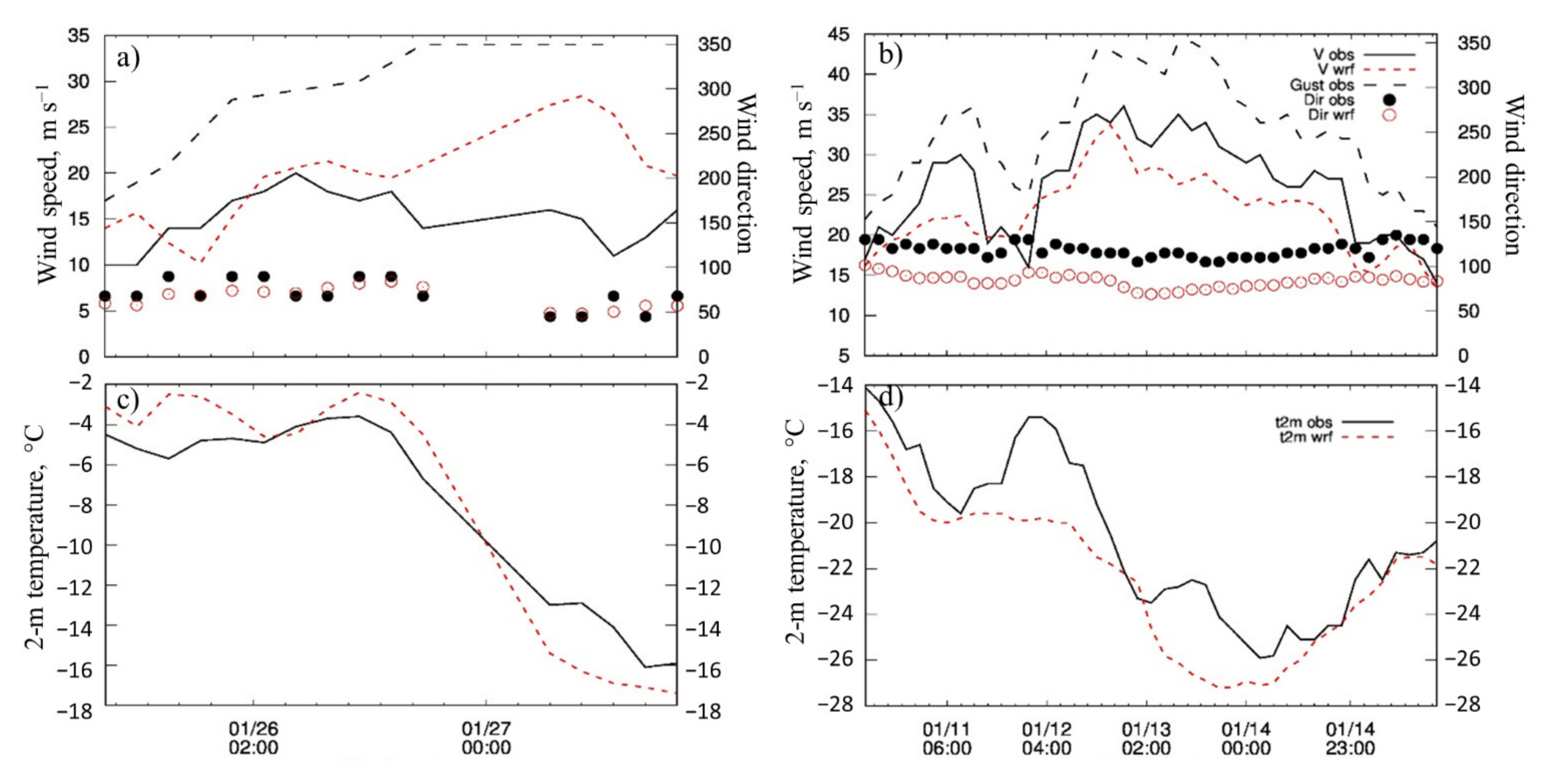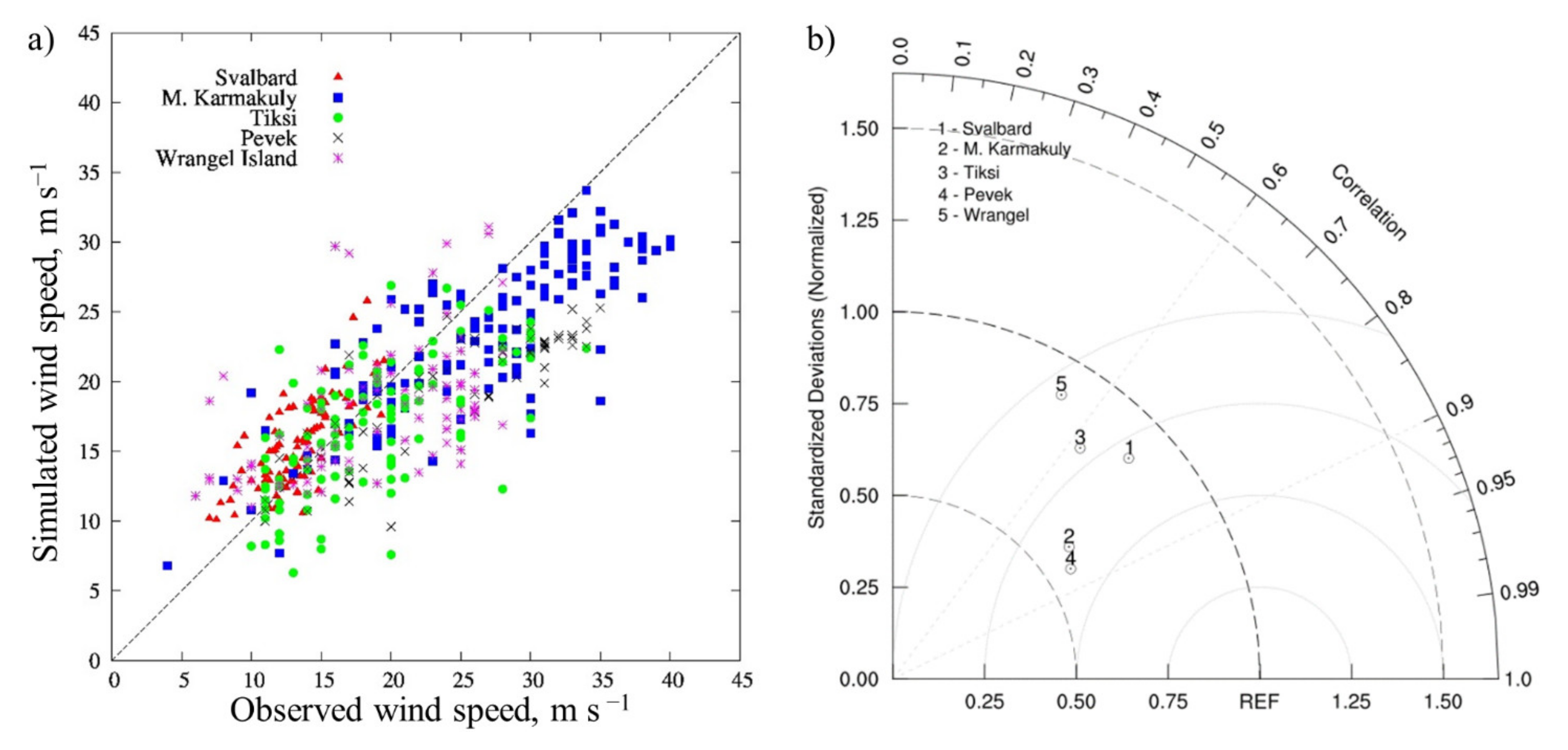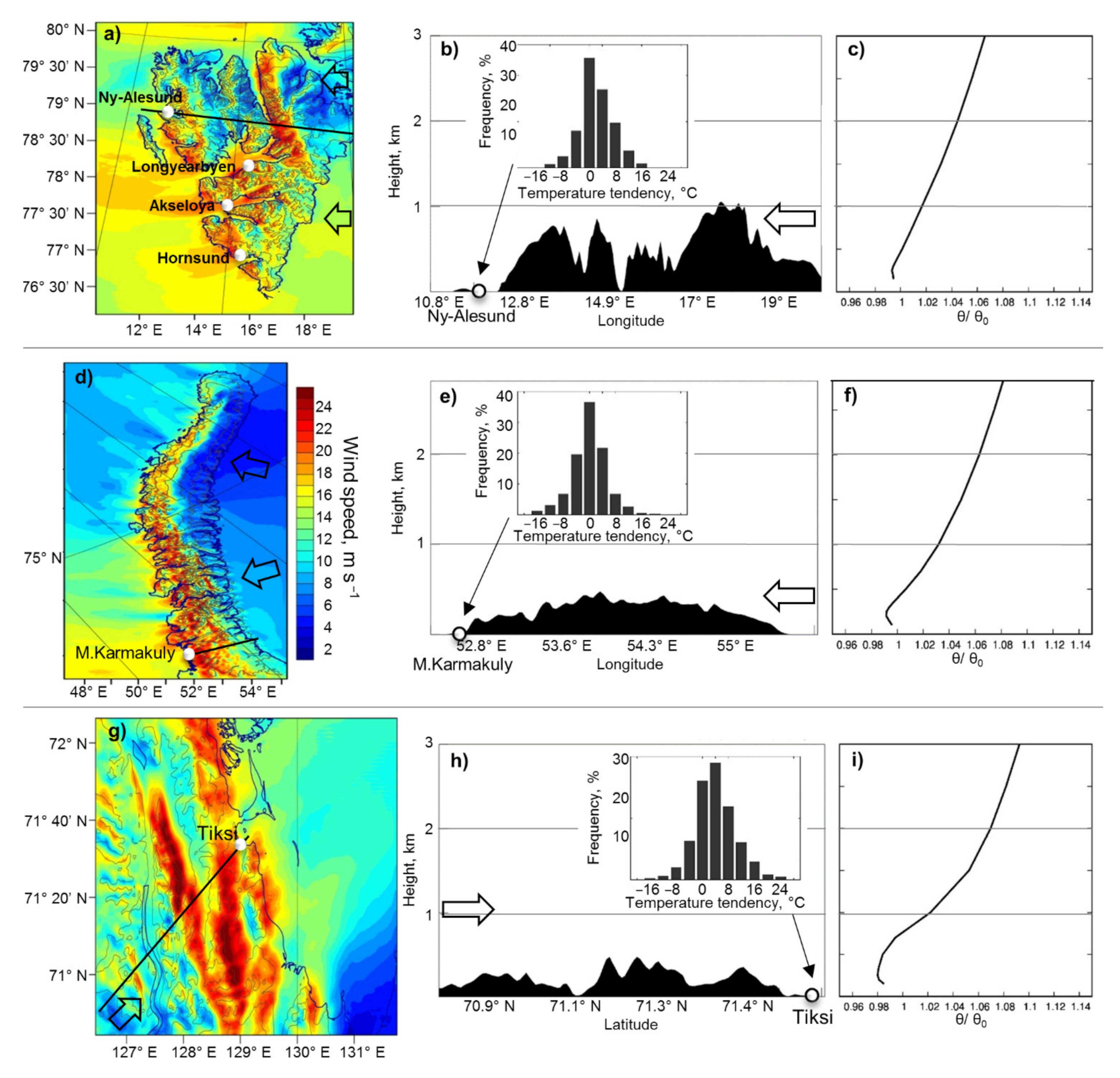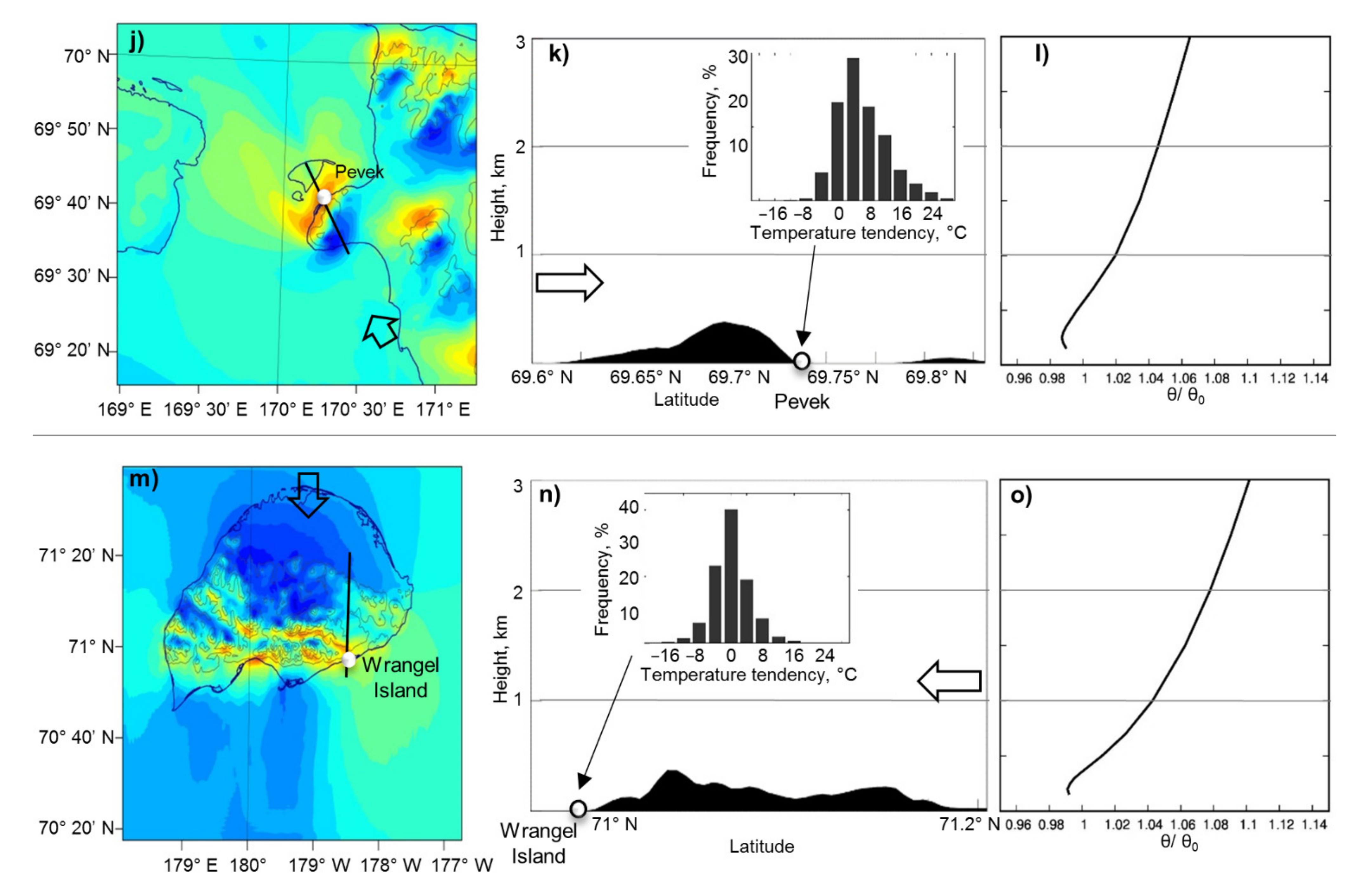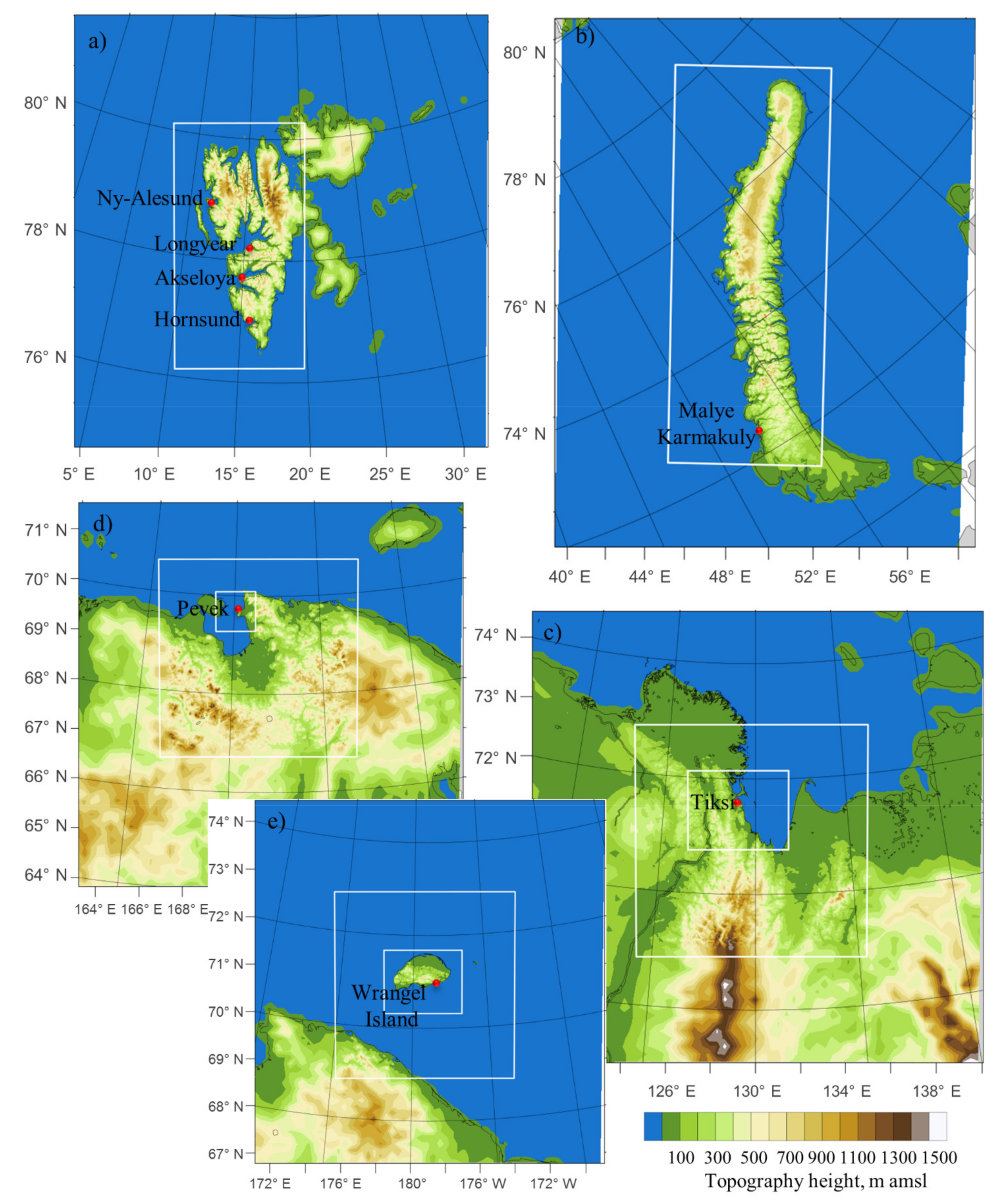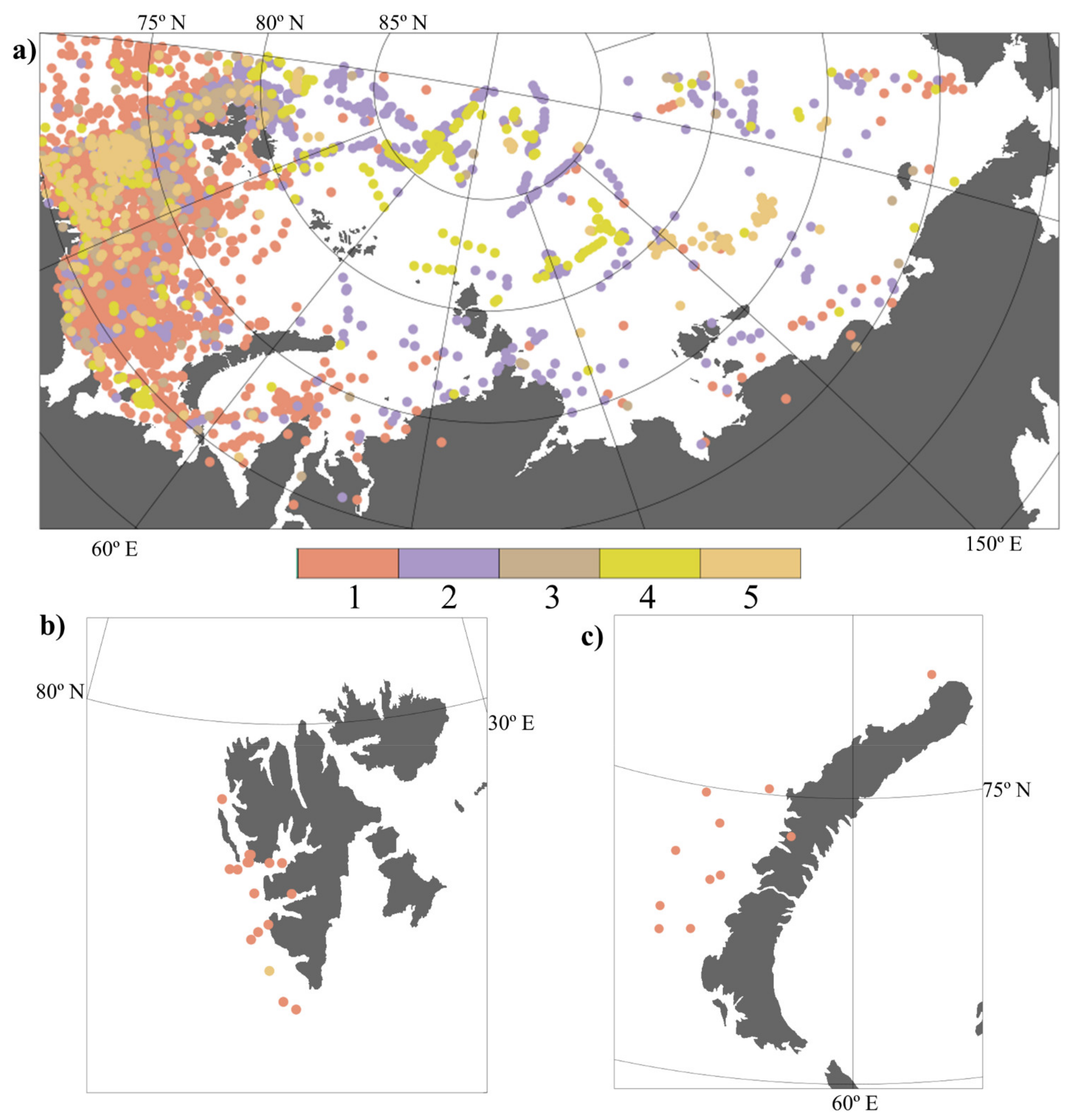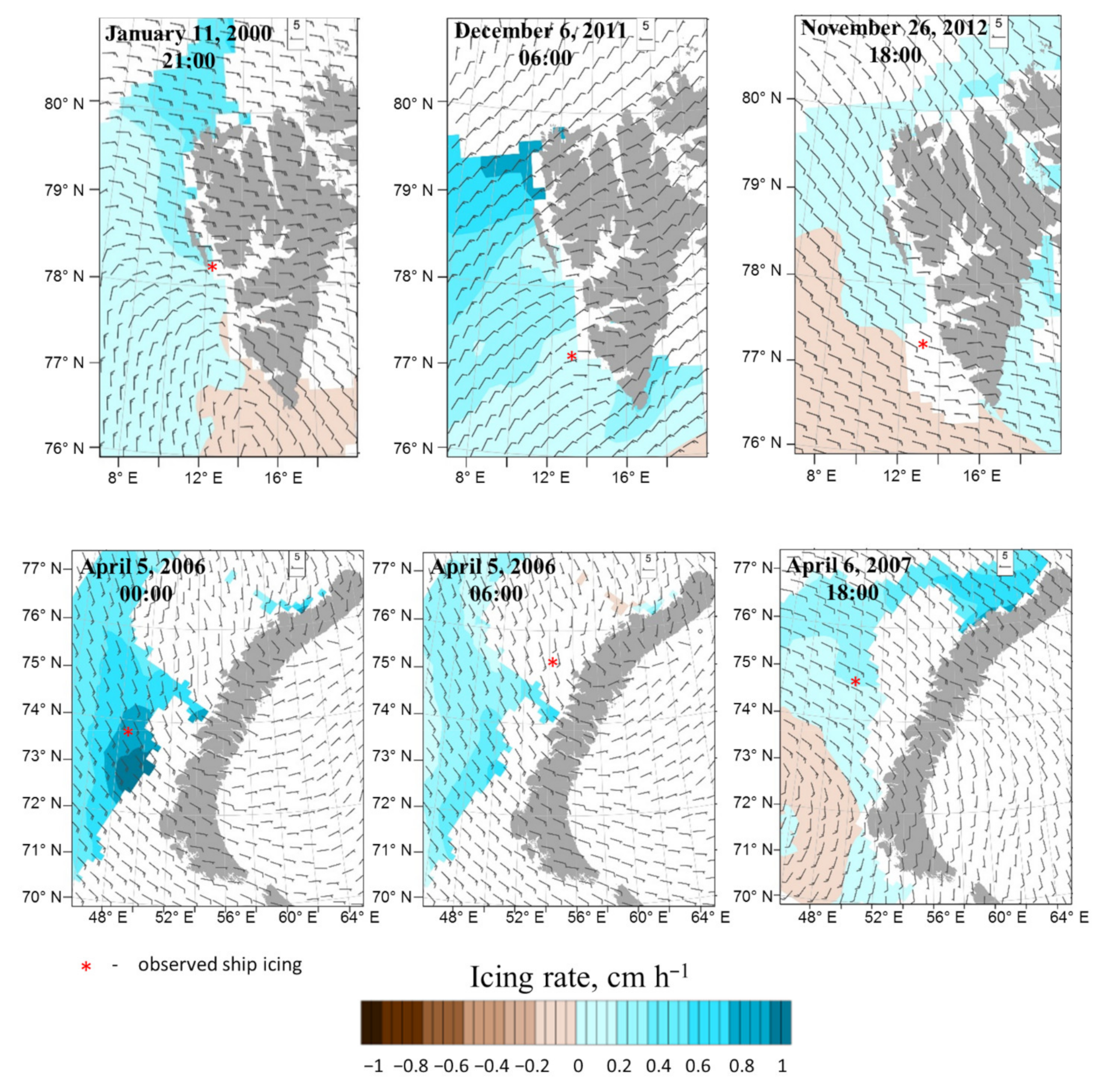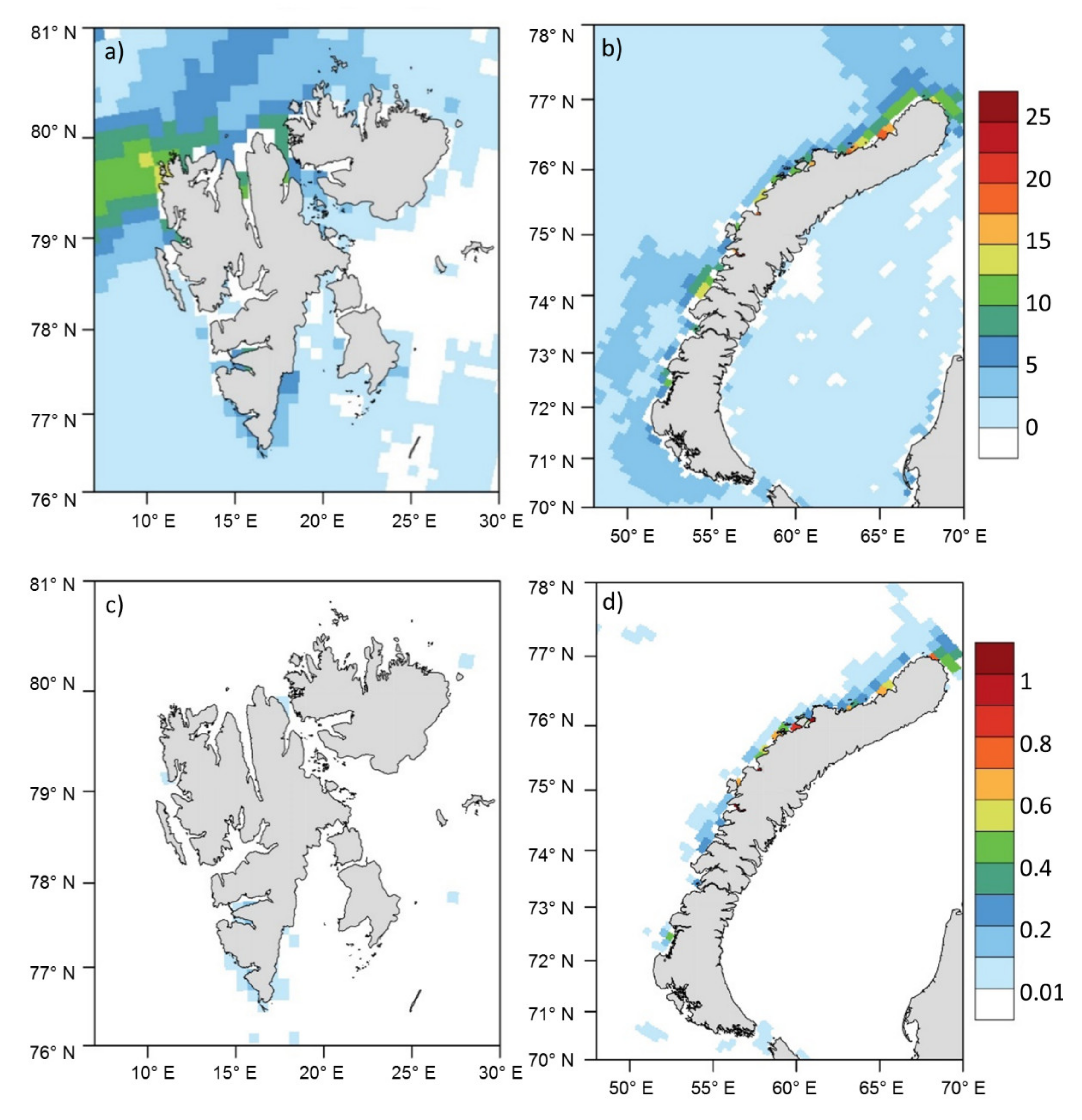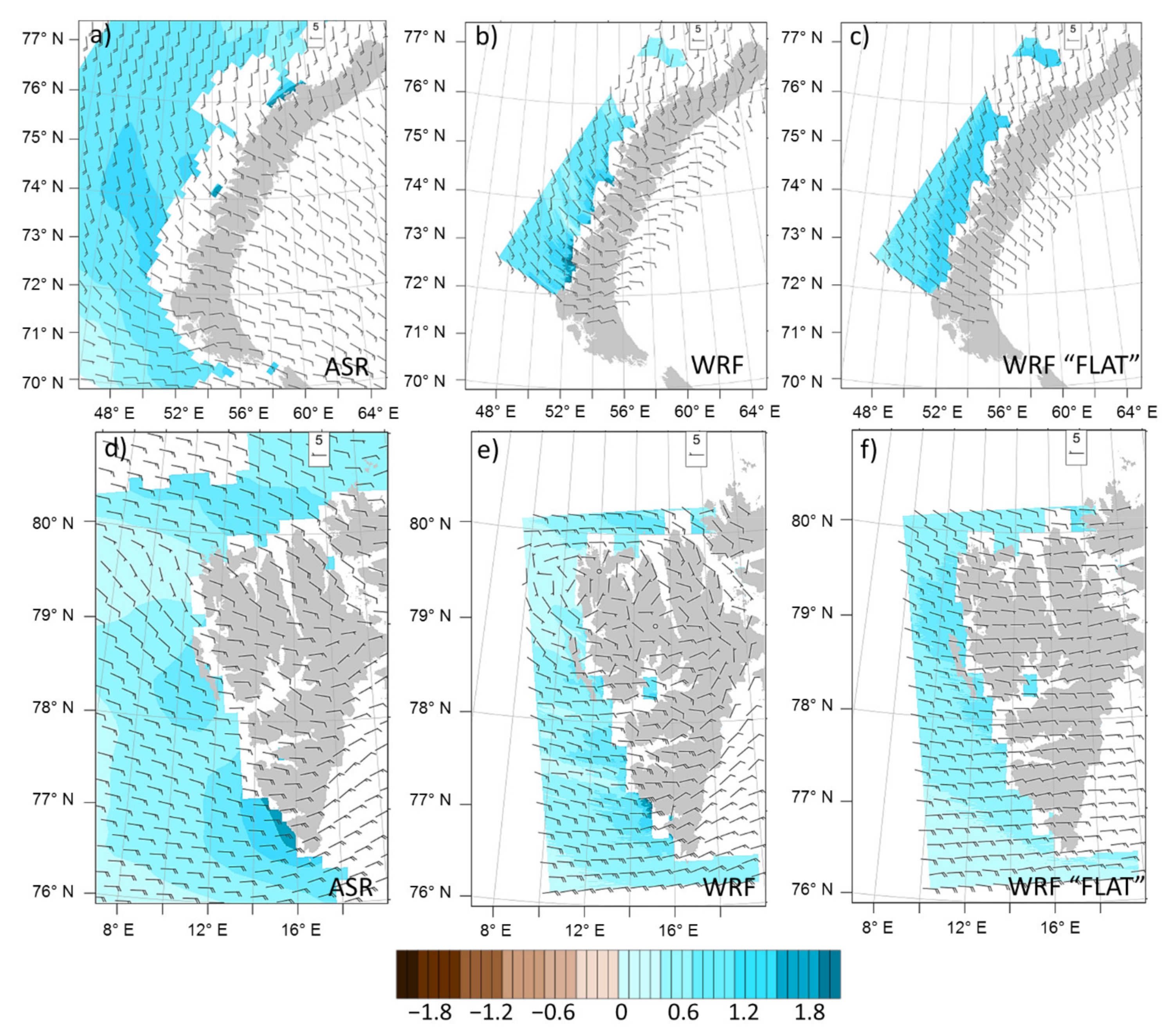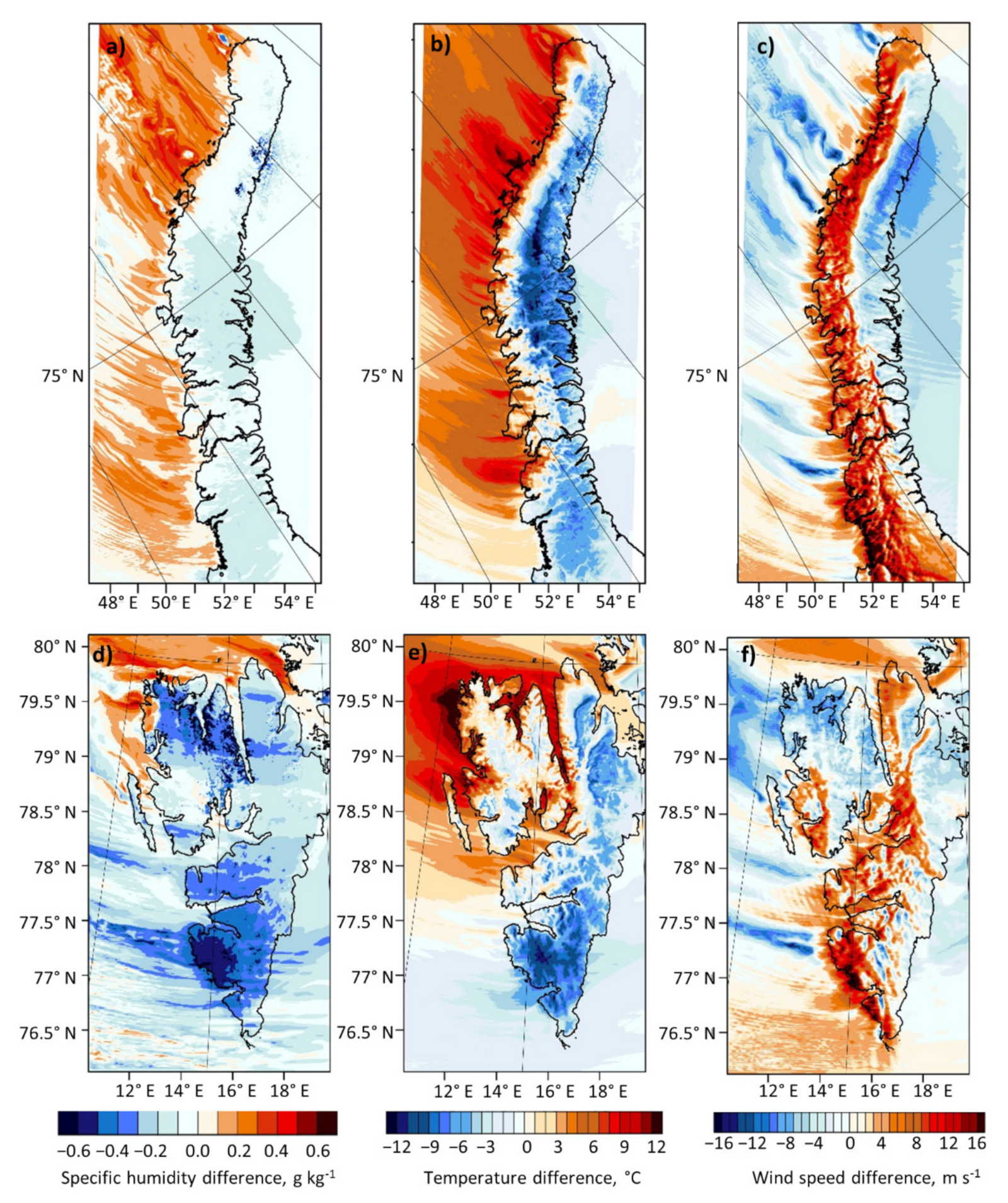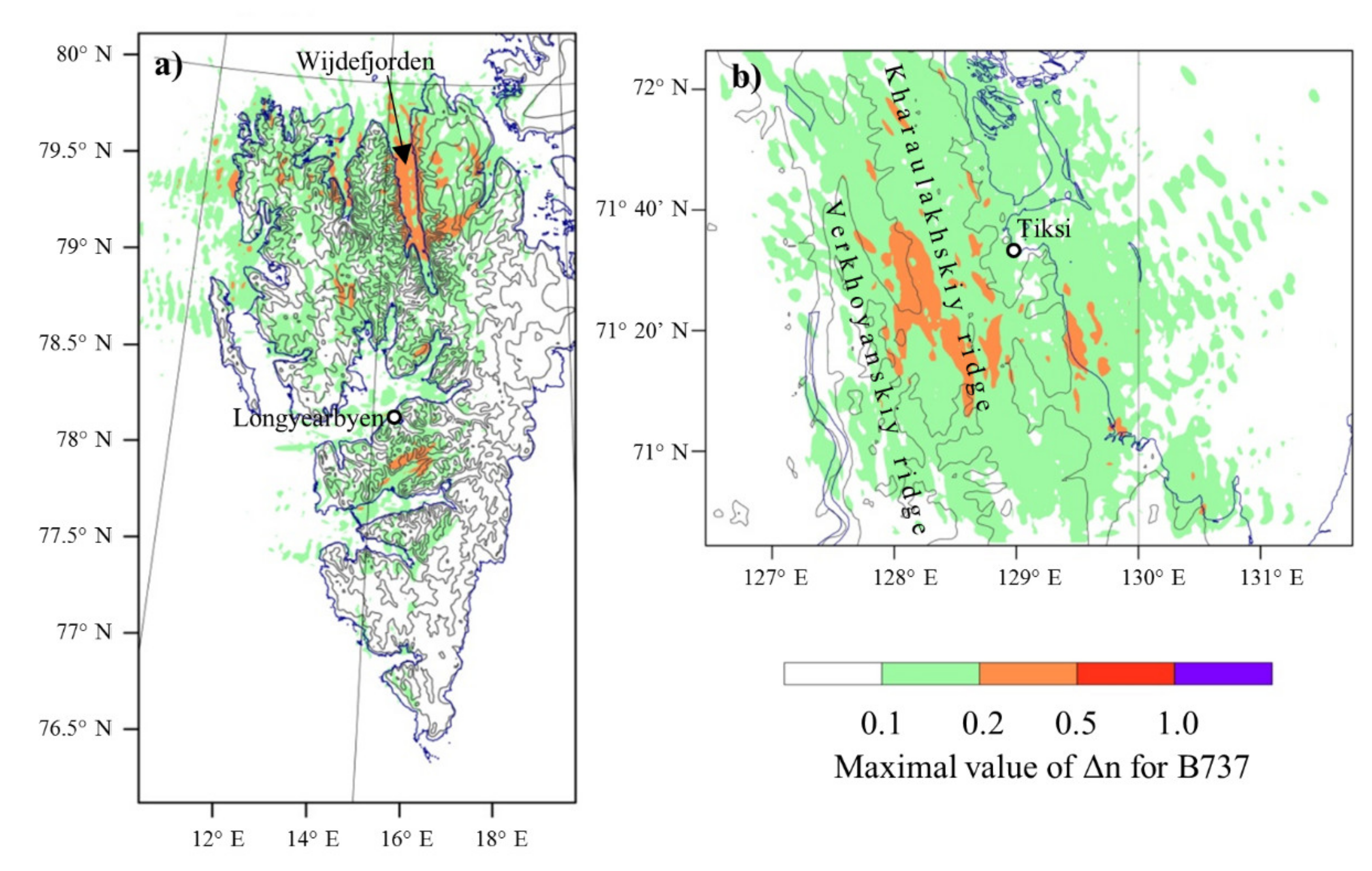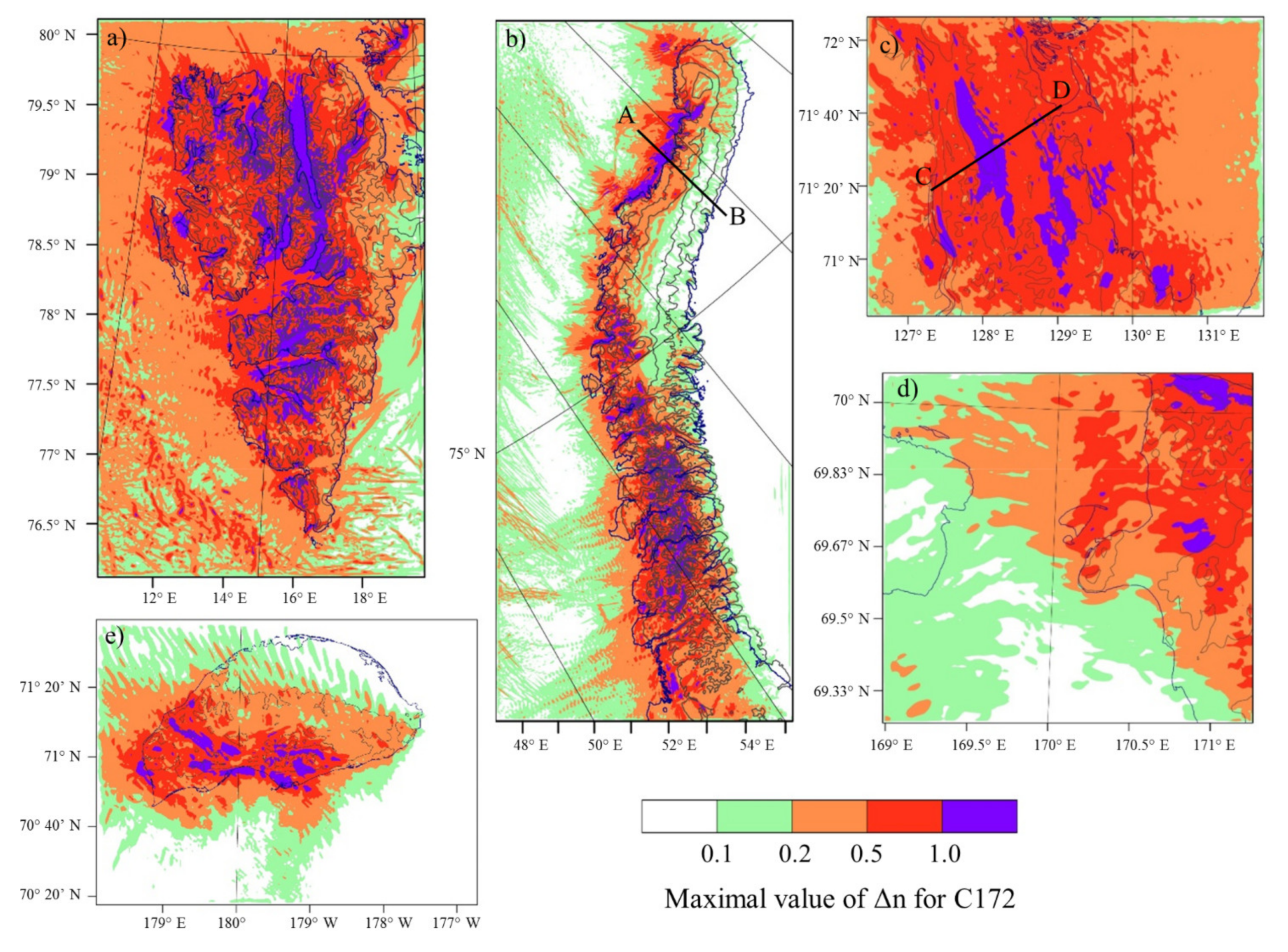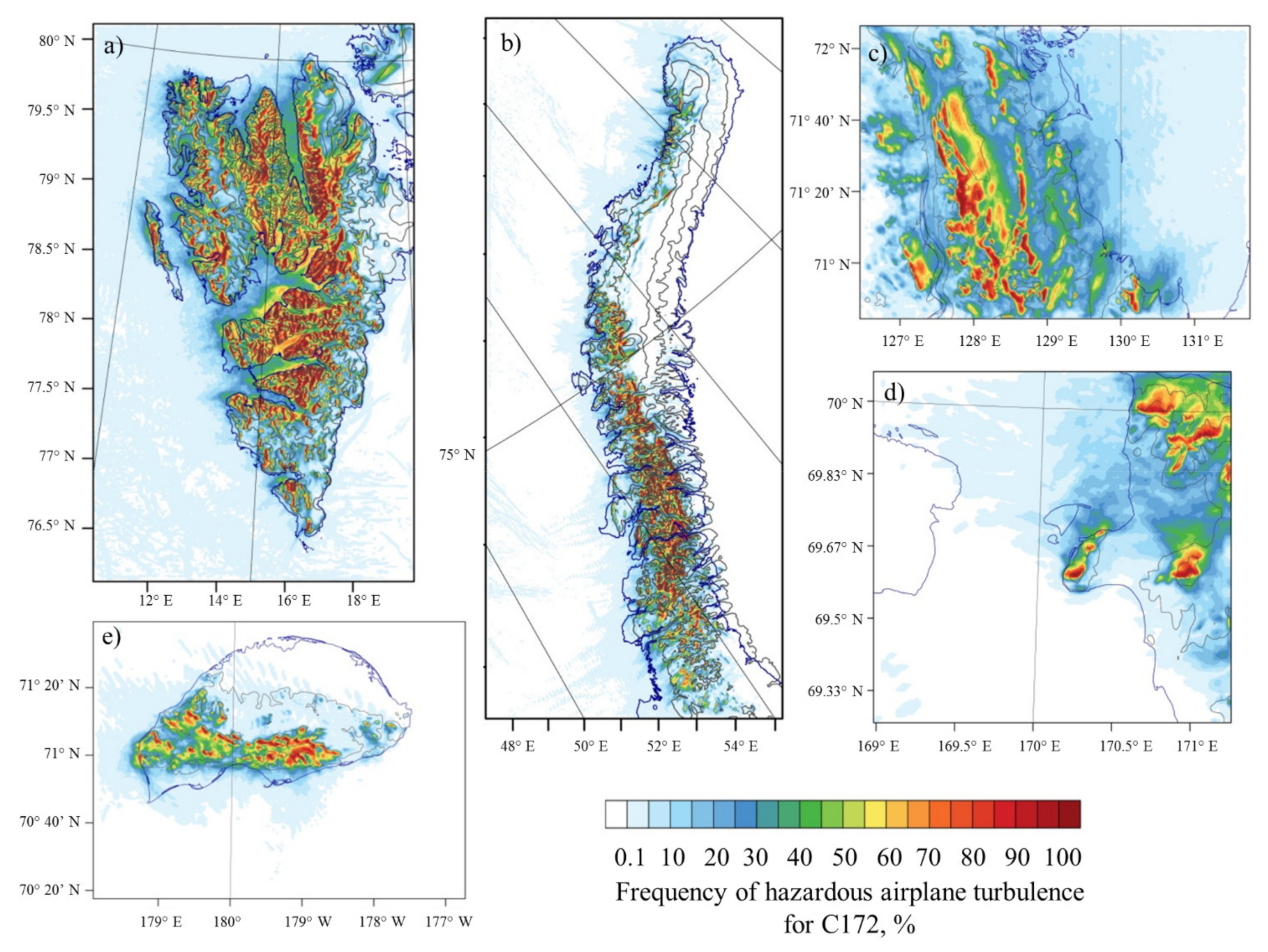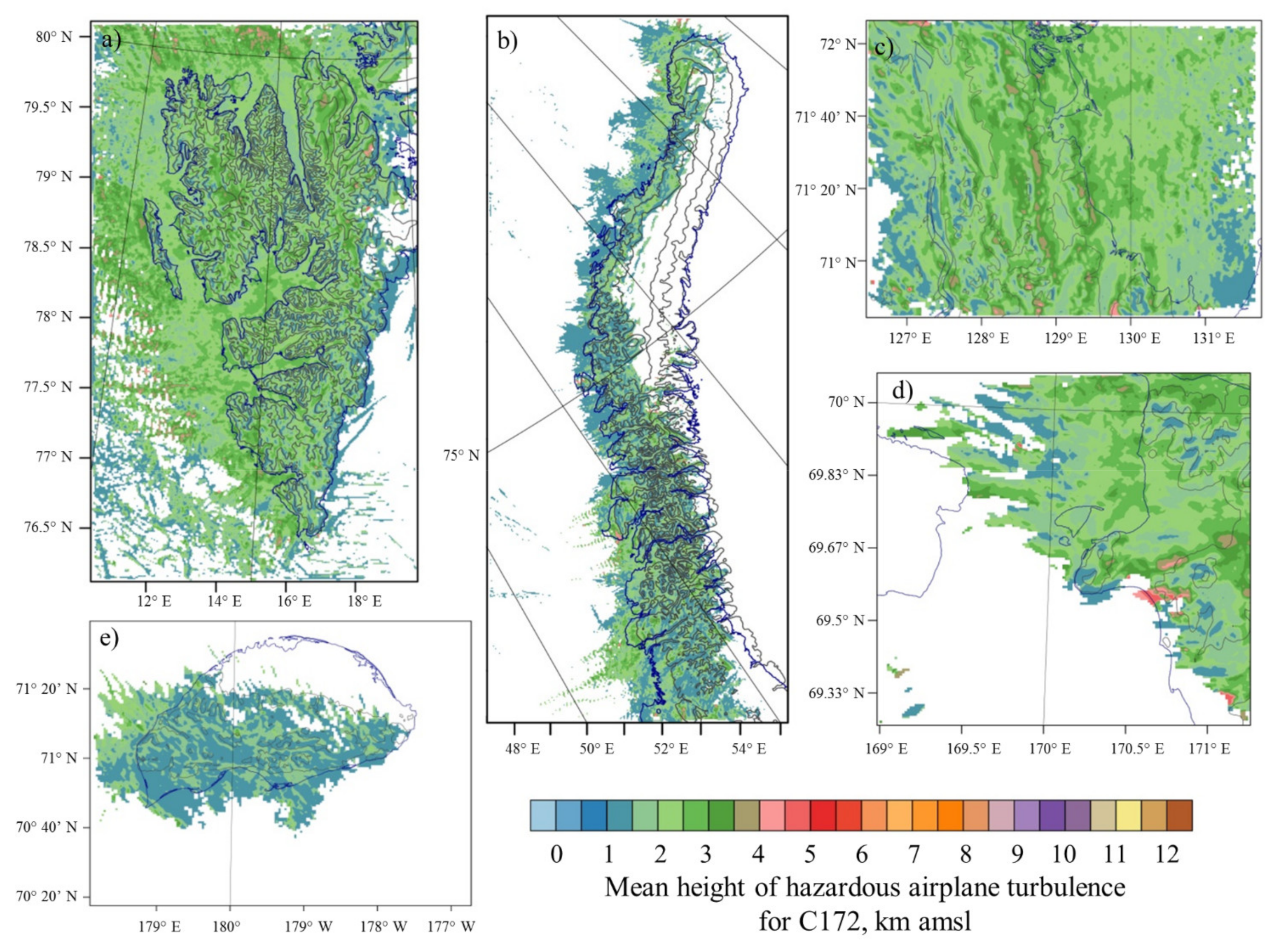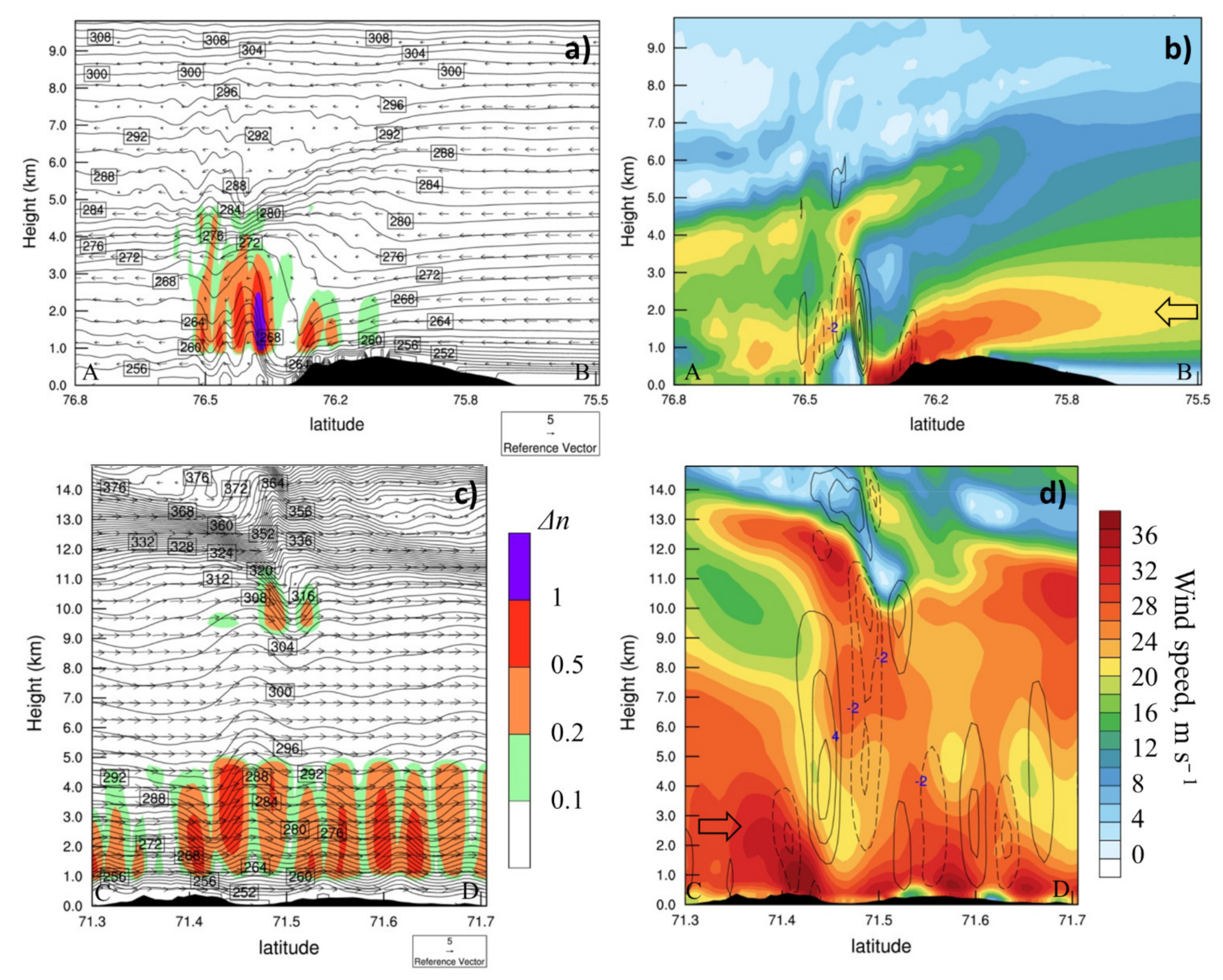1. Introduction
Downslope windstorms are generally induced by mountain wave amplification [
1], resulting in strong winds on the foot of the lee slope of the mountain. Local winds “bora” and “foehn” (e.g., [
2,
3]) are a kind of downslope windstorms. In the Arctic, downslope windstorms are known on Novaya Zemlya archipelago (both at its western and eastern sides) [
4,
5], in Pevek (Chukotka) [
6], as well as on Svalbard [
7,
8,
9], in Tiksi (Yakutia) and on Wrangel Island [
10]. A review on satellite observations of these winds is given in [
11]. The climatology of these winds is summarized in [
12,
13]. According to station observations, the strongest downslope windstorms are observed on Novaya Zemlya and in Pevek (with gusts up to 50 m s
−1), and the weakest on Svalbard [
13]. Downslope windstorms on Svalbard and Novaya Zemlya frequently occur with an easterly background flow (
Figure 1a,d), although there are also downslope windstorms on the east coasts [
4]. Downslope windstorms on Svalbard are usually called “foehns” (e.g., [
8,
9]), though only half of times they lead to temperature increase (
Figure 1b). Downslope windstorms on Novaya Zemlya, called “bora”, are observed very frequently (on average, 138 days per year). In 4% of cases its speed exceeds 30 m s
−1. This downslope windstorm could lead to both increase and decrease in air temperature (
Figure 1e). In Tiksi and Pevek, downslope windstorms occur about 80 days per year with southwesterly and southeasterly winds, respectively, therefore, they are usually accompanied by a sharp increase in temperature (
Figure 1h,k), especially in Pevek. On Wrangel Island downslope windstorm is recorded at a meteorological station with a northerly air flow, with a nearly equal probability of temperature increase and decrease during downslope windstorm (
Figure 1n). This wind is rather mild but occur frequently (on average, 95 days per year). Incoming flow in the troposphere for all downslope windstorms usually consists of three layers with different temperature stratification: lowest near-neutral or even unstable layer, an elevated inversion (less pronounced on Svalbard) and a layer with a lapse rate of standard atmosphere above (
Figure 1c,f,i,l,o).These downslope windstorms have not previously been considered in detail in terms of the accompanying weather hazards for transport, such as vessel icing and turbulence causing aviation hazards.
Severe turbulence encountered by aircraft was observed many times during downslope windstorms [
14,
15,
16,
17,
18]. For instance, Ralph et al. (1997) analyzed the case of strong turbulence near the tropopause due to mountain waves that were observed simultaneously with the Chinook downslope windstorm on the eastern slopes of the Rocky Mountains; as a result, the engine and part of the wing were torn off one of the aircraft. Such turbulence occurs due to internal gravity waves that propagate upward from the mountains when the air flows over an obstacle. These waves, under favorable conditions, amplify and break, creating local unstable layers with enhanced turbulence. However, even in the absence of wave breaking, these waves induce strong vertical motions that pose a danger to aviation. Also, strong turbulence could occur on the lower layers, due to lee waves and hydraulic jumps. The latter occurs when flow transits from supercritical to subcritical state at some distance from the lee slope or just over the slope. Hydraulic jumps are often observed during severe downslope windstorms [
19]. Most of research considers hazardous turbulence in the upper troposphere, on flight legs of commercial jets.
To assess the risk of aviation hazards, the use of reanalysis is not convenient, since their resolution is not enough to accurately reproduce orography that creates high-amplitude gravity waves. The author is not aware of observational data on such turbulence in the Arctic. Therefore, the only possible tool for assessing aviation hazards during downslope windstorms is numerical model with high spatial and vertical resolution. It is very costly to estimate the frequency of turbulence occurrence with high-resolution model in every considered region since long-period calculations require too many computational resources and time. In this paper, estimations of the characteristic intensity, regions of occurrence and the height where aviation turbulence arise in each region are presented for several cases of strong downslope windstorms.
Many predictors can be used to assess potential areas of clear air turbulence (including orography-induced). For instance, the Graphical Turbulence Guidance System [
20] includes many such predictors: Richardson number, frontogenesis function, eddy dissipation rate and others. In this research, the emphasis is not on the calculation of atmospheric turbulence characteristics, but on the calculation of characteristics that directly assess the danger to aircraft associated with strong vertical motions. International Civil Aviation Organization (ICAO) has adopted special indicators for wind shear: F-factor and I-factor [
21]. However, these indicators can only be calculated for a specific flight tracks (e.g., [
17,
22]), since they include the wind speed along the flight track. In the general case, to assess the potential of hazardous aviation turbulence for the region as a whole, the headwind speed is unknown (since the flight route can be any). Indicators that are depend only on vertical velocity and aircraft technical features are used here. These indicators are aircraft angle of attack change and load factor change, which were proposed as predictors of aviation turbulence (this definition is used throughout the paper) in the classic monograph on aircraft aerodynamics [
23] and were used in a number of Russian studies devoted to the safety of flights over mountains of Iran, Crimea, Adygea, Kuznetsk Alatau (Siberia), Dzhugdzhur Mountains (Russian Far East), and Karatau Mountains (Kazakhstan) on the basis of simulations [
24,
25,
26].
Vessel icing is one of the greatest hazards to shipping in the Arctic [
10,
27,
28]. Most often, vessel icing occurs when splashing seawater by sea waves [
29,
30]. This type of icing is called spray icing. During downslope windstorms, the wind speed increases significantly and the temperature sometimes decreases sharply on the lee side of the mountains (
Figure 1b,e,h,k,n) when cold air advection, which creates the preconditions for the occurrence of spray icing. Such downslope windstorms create three-dimensional steep sea waves [
31] that in company with strong gusty wind ripping off droplets form the wave crests provide the source of spray. For instance, ship icing is frequently observed during Novorossiysk bora (Russian coast of Black Sea), causing great damages [
32,
33]. According to Russian Barents Sea Pilot [
29], icing is especially intense in the coastal waters of the Novaya Zemlya archipelago. Panov (1978) mentioned that icing in the Barents Sea is most frequently observed during the northeasterly winds. Thus, one may suggest the influence of bora on this local icing maximum. Indeed, Bryazgin and Dementiev (1996) mentioned the fact of vessel icing during Novaya Zemlya bora. Recently (28 December 2020) the ship Onega sank in the Barents Sea, 17 people died (
https://www.bbc.com/news/world-europe-55467244 (accessed on 9 June 2021)); rapid ice accretion is called one of the versions of this accident. This happened during the Novaya Zemlya bora with wind gusts up to 32 m s
−1. Vessel icing was also observed during downslope windstorms in Svalbard [
27], despite the frequently occurring temperature rise (see
Figure 1b and [
13]), which should reduce possible icing.
Ship observations of icing are clearly not enough to assess the risk of vessel icing in the Arctic. There are many methods for estimating the icing rate, most of which are based on the heat balance of the ship surface, on which the sprayed water freezes (e.g., [
34,
35,
36,
37]). This approach shows satisfactory results when compared with observational data [
34,
38] and allows calculations on the basis of reanalysis, since the input parameters (wind speed, air and sea surface temperature, air humidity, radiative fluxes) are available in all reanalyses. Reanalysis data are widely used for calculating vessel icing and compiling its climatology (e.g., [
28,
39]).
This research aims to obtain an assessment of the risks of vessel icing and aviation turbulence during downslope windstorms in five regions in the Arctic: on the western coasts of Svalbard and Novaya Zemlya, in Tiksi and Pevek, and on Wrangel Island (see
Figure 1 and
Figure 2).
Section 2 describes the methods used to calculate vessel icing and aviation turbulence, the observational data involved, and a description of the numerical simulations.
Section 3 and
Section 4 present the results of the risks assessment. The main findings are summarized in
Section 5.
3. Frequency and Intensity of Vessel Icing during Downslope Windstorms
Figure 3a shows all cases of vessel icing for the period 1966–2019 in the Russian Arctic, found in the ICOADS3 database. Comparison of these data and downslope windstorms calendars in different regions revealed several cases of icing (
Figure 3b,c) during downslope windstorms on Svalbard and Novaya Zemlya (the absolute majority of them are spray icing). In all these cases, slow freezing, slow melting or no freezing (meaning that icing occurred before the observation period) was observed. The ice thickness was in most cases 1–2 cm, but in two cases it reached 6 cm (24 January 1996 in Svalbard region and 8 February 2001 in Novaya Zemlya region). In the rest of the regions, no cases of icing during downslope windstorms were detected, possibly not only because of the low intensity of icing in these regions, but also because of the small number of observations in the eastern Arctic and ice cover during the cold period, when most of strong downslope windstorms are usually observed [
13].
Figure 4 shows calculated icing rate on the basis of reanalysis data for some cases of observed icing. In general, the chosen method reproduces icing in the area where it was observed. However, there are several cases when a point with icing observations falls on an area with sea ice in the reanalysis (for example, at 18:00 26 November 2012 and at 06:00 5 April 2006,
Figure 4). The observations themselves do not provide accurate information on where the icing was observed, since it could have occurred before the time of observation, and the vessel could have deliberately moved into the sea ice to reduce icing (a standard method for dealing with vessel icing [
34]).
Statistics on the icing rate, calculated on the basis of reanalysis data for the period 2000–2016, is consistent with the observations: the highest among all considered downslope windstorms frequency of vessel icing is noted for the Novaya Zemlya and Svalbard downslope windstorms (
Table 2). The intensity of icing is light in the overwhelming majority of cases, and the proportion of cases with moderate icing (of the total number of times when downslope windstorm was observed) reaches 15% in Svalbard region and 26% in Novaya Zemlya region (
Figure 5,
Table 2). The maximum frequency of heavy icing reach 0.2% in Svalbard (in winter and spring) and 2% in Novaya Zemlya (mainly in winter) regions. According to these calculations, the icing rate during the Novaya Zemlya downslope windstorms reach 7 cm h
−1, which is a very heavy icing. In Tiksi and Pevek, icing is practically not observed, but on the contrary, conditions for ice melting prevail (the mean value of icing rate is negative). On Wrangel Island, bora is accompanied by light icing in 30–50% of cases, and by moderate icing in 1–4% of cases.
Figure 5a shows that the predominant icing area in Svalbard region is the northern tip of the archipelago, close to the sea ice edge position. This is due to cold air outbreaks onto the open sea surface in the Fram Strait usually observed along with downslope windstorm. Also tip jets are usually observed to the south and to the north of Svalbard (e.g., [
48]), which are favorable for icing due to increased wind thereof. The percentage of cases with moderate to heavy icing directly off the western shores of the archipelago, in the areas of direct downslope windstorm influence, is rather small (
Figure 5c). The highest frequency of heavy icing is in the fjords and off the coast of southern Spitsbergen. The picture is different on Novaya Zemlya: the area of the highest frequency of moderate (and also heavy) icing is extended along the western coast and is maximal near the coast (
Figure 5b,d). In winter and spring, heavy icing was found along the entire coast (although in spring no icing is observed in the very north due to sea ice) with a maximum in the north in winter and in the center of the coast in spring.
It may seem that much of the icing cases on Novaya Zemlya and Svalbard are related to cold air outbreaks that are observed simultaneously with downslope windstorms. However, the effect of downslope windstorms itself on the vessel icing can be revealed when analyzing simulations with and without orography (
Figure 6). Areas of maximum icing rates in the control experiment (
Figure 6b,e) coincide with areas of strong downslope wind near the coast; the icing rate decreases sharply in wakes (for example, downstream the Northern Spitsbergen). In the control experiments, as well as in the calculations with reanalysis (
Figure 6a,d), vessel icing reaches the degree of heavy icing, which does not occur in the “Flat” experiments (
Figure 6c,f). The maximum icing rate in the experiment with (without) the influence of downslope windstorms is 3.2 (1.7) cm h
−1 in the Novaya Zemlya region and 2.6 (1.1) cm h
−1 in Svalbard region. Thus, downslope windstorms in these regions approximately double the maximum icing rate. In the absence of orography, the area occupied by moderate icing increases in comparison with the control experiment, while the area of light icing decreases in the “Flat” experiments. This is due to the spatial structure of the wind pattern characteristic of downslope windstorms, namely jets and wakes, which are absent in the experiment without orography.
Figure 7 explains the reasons for the change in the icing rate under the influence of downslope windstorms. Three regions can be distinguished where the effect of downslope windstorms on the near-surface wind speed, temperature and humidity was different. On Novaya Zemlya, specific humidity and temperature increased everywhere on the mountains lee side (due to partial blocking of colder and drier air by mountains) in the “WRF” experiment comparing with “WRF Flat” experiment, and at the same time the wind speed increased. Since the air temperature in both episodes was significantly lower than the freezing point of seawater, an increase in temperature and humidity led to a decrease in gradients in formulas (4) and (5), which should lead to a decrease in turbulent fluxes. However, since the effect of the downslope windstorm on the wind speed was much stronger than on the temperature and humidity, the resulting turbulent fluxes increased, which led to increased icing according to (3)–(5). In the northwestern Svalbard, temperature and humidity have also increased due to downslope windstorm, but the wind speed decreased due to wake formation. All three of these factors led to a decrease in icing rate (
Figure 6e,f). Finally, in the south of Spitsbergen, a downslope windstorm led to a decrease in air temperature and humidity to the lee of mountains, and the wind speed increased significantly, which led to an increase in icing rate. A decrease in temperature, unusual for foehn winds, occurred in this area due to change in the direction of the incoming flow (compare the direction of the wind on the windward side in
Figure 6e,f). The presence of topography forced the air to flow around the archipelago, so the wind direction upwind the southern Svalbard became more northerly, which means that colder air was advected. Thus, the direction of temperature advection had an even greater effect on the resulting temperature on the lee side than the foehn effect (adiabatic heating of the descending air). Summarizing, the wind plays the primary role in the intensification of icing on Novaya Zemlya and in the south of Svalbard during downslope windstorms in considered episodes.
Figure 6 also demonstrates the adequacy of the icing rate calculations with reanalysis, since even at a relatively low resolution compared to simulations, it closely reproduces the icing rate and the main regions with the maximums of this value. The main differences between simulations and reanalysis for the cases shown in
Figure 6, as well as for all other cases, are due to differences in the sea ice boundary.
Sea ice cover is the main reason of absence of vessel icing during downslope windstorms in Tiksi and on Wrangel Island. All previous calculations were carried out only for those cells where there is no ice at all (cells with open water). The icing rate for all simulated episodes was also calculated without taking into account the sea ice (not shown), that is, sea ice was replaced by open water in all grid cells, setting surface temperature to 0 °C. Although even the most severe scenarios of global warming do not predict the freeing of the Eastern Russian Arctic from the sea ice by the end of the 21 century in winter and spring (see
https://cds.climate.copernicus.eu/cdsapp#!/software/app-globalshipping-arctic-sea-ice-extent-projections?tab=overview (accessed on 9 June 2021)), but some areas are predicted to be ice-free in the autumn. Calculations without sea ice showed that heavy icing occurred in all episodes of downslope windstorms on Wrangel Island, and in four episodes out of five in Tiksi (only moderate icing was observed in one episode). There was no heavy icing even without ice in any of the episodes of Pevek downslope windstorm, where downslope winds bring the strongest warming on the lee side among other regions (
Figure 1k, see also [
13]). Moderate icing was noted in three episodes of Pevek downslope windstorm, and in the other two, conditions for light icing or ice melting prevailed.
4. Intensity, Characteristic Regions, and Height of Aviation Turbulence during Downslope Windstorms
Simulations revealed the presence of a hazardous aviation turbulence during downslope windstorms in all considered regions for C172 and on Svalbard and in Tiksi region for B737.
Figure 8 and
Figure 9 shows the maximum values of Δ
n for each region (a composite of all simulated episodes) for B737 and C172, respectively,
Figure 10 shows the frequency of hazardous aviation turbulence for C172, and
Figure 11, the average height of hazardous turbulence for C172.
Generally, the highest values of Δn were observed in the valleys downstream from the leeward slopes, while the highest frequency of hazardous aviation turbulence was found on the lee slopes. This is due to the fact that intense downward air motions are always observed precisely over the leeward slope, which causes them. However, upward movements—observed in hydraulic jumps or in lee waves downstream—are usually more intense. The distance from the lee slope at which a hydraulic jump or lee wave is observed can vary greatly, since it depends on the parameters of the incoming flow.
On Svalbard, hazardous aviation turbulence for B737 was found in 11% of all considered cases with downslope windstorms. Though it did not reach the degree of strong. It was found in the north, in Wijdefjorden and in some other areas, as well as in the central part, south of Longyearbyen (
Figure 8a), at an altitude of 9–9.5 km. Hazardous turbulence for C172 most often (almost always) was observed over the lee slope of the highest ridge of Spitsbergen, in the northeastern part, and in many other areas, including the Longyearbyen area (
Figure 9a and
Figure 10a). The typical average height of this turbulence is 2–3 km (
Figure 11a).
On Novaya Zemlya, the greatest frequency of hazardous turbulence for C172 was found in the central part of the archipelago (over some slopes, in up to 100% cases), where the orography is very rugged. In the south, in the weather station area, and in the north, this turbulence is less frequent (
Figure 10b). The height of this turbulence generally varies from 1 to 3 km (
Figure 11b). One of the strongest aviation turbulence was noted in the north, in an intense hydraulic jump on 14–15 January 2006 (
Figure 12a). Strong stratification (with the Brunt-Väisälä frequency of 0.03 s
−1) and mild wind speed (on average, from 4 to 8 m s
−1) in the incoming flow contributed to low Froude number. A nonlinear flow regime with a hydraulic jump (according to the hydraulic theory) or a zone of low-level wave breaking (according to wave theory) forms in such a case [
19]. For the example in
Figure 12b, vertical velocity in a hydraulic jump reached 10 m s
−1.
In Tiksi region, hazardous turbulence for B737 (
Figure 8b) was found in 14% of all cases with a downslope windstorm. It occurred when gravity waves propagated to the stratosphere and just under the tropopause they amplified due to a decrease in air density and possibly resonance effects (
Figure 12c,d). The vertical velocity at altitude of 10 km reached 6 m s
−1 (
Figure 12d). Hazardous turbulence for C172 was most often observed on the lee slopes of the Verkhoyanskiy and Kharaulakhskiy ridges (almost in all cases) (
Figure 10c), but the strongest turbulence was at their foot, in the valleys (
Figure 9c). This area of strong turbulence in the valley between Verkhoyanskiy and Kharaulakhskiy ridges was quite stationary; it might shift slightly, but was observed in all simulated episodes.
In the Pevek region, hazardous turbulence for C172 was noted not only in Pevek itself, but also over other ridges to the east (
Figure 9d). The frequency of this turbulence over the Pevek ridge and ridges to the east reached 100% (
Figure 10d). The height of the turbulence varied widely, from 1 to 5 km, but in areas with the maximum frequency, it was usually 1–2 km (
Figure 11d).
There was a moderate aviation turbulence for C172 above the Wrangel Island weather station and a strong turbulence in the mountains to the west (
Figure 9e). Above the highest mountains and their lee slopes, this turbulence was almost always present according to simulations (
Figure 10e). The average height of this turbulence was 1.5 km (
Figure 11e).
5. Conclusions
Five regions with downslope windstorms in the Russian Arctic were considered for the risk assessment of hazardous vessel icing and aviation turbulence. Chosen methods of calculating the icing rate and aviation turbulence parameters were applied to reanalysis and/or simulations. The latter were performed for severe episodes of downslope windstorms with the WRF-ARW model with high spatial resolution. The following results were obtained.
The highest frequency of hazardous vessel icing was noted for Novaya Zemlya and, to a lesser extent, for Svalbard downslope windstorm. The low frequency of icing on Wrangel Island and in the Tiksi region is associated primarily with sea ice cover most of the year, since in the absence of ice, as idealized calculations on the basis of simulations for strong episodes have shown, the icing was heavy in the vast majority of simulated episodes. Thus, if cold-season sea ice in the Eastern Russian Arctic ever disappear in the future, one could expect heavy icing during strong downslope windstorms in these regions. Even the fact that downslope windstorms in Tiksi lead to a temperature rise in most of the cases [
13] does not prevent ships from icing, as in Svalbard. On the contrary, icing in Pevek region was light to moderate even in the absence of sea ice and even for strongest downslope windstorm episodes, because this downslope windstorm is very warm.
The highest icing rate was found for Novaya Zemlya downslope windstorm; in some areas near the coast, the frequency of heavy icing can reach 5% of cases. This is explained, firstly, by the very high wind speed during this downslope windstorm and, secondly, by proximity of the western coast of Novaya Zemlya to climatological mean sea ice edge position [
49]. Since the downslope windstorm itself does not propagate far into the sea, the areas of heavy icing are concentrated near the coast. Numerical experiments with and without taking into account the orography (and, consequently, the downslope windstorm) for the regions of Novaya Zemlya and Svalbard have shown that it is downslope windstorm that leads to the occurrence of severe icing off the coast. Downslope windstorms lead to an approximate two-fold increase in the maximum icing rate.
Aviation turbulence, hazardous for light aircraft Cessna 172, was found in all considered regions in each of the simulated episodes of strong downslope windstorms. This turbulence occurred very frequently and not only over the mountains, but also downstream, over the sea, due to lee waves and hydraulic jumps. Typical regions where this turbulence occur most frequently in simulations were revealed. In most regions, hazardous turbulence occurred at altitudes from 1 to 4 km. Hazardous turbulence for Boeing 737, calculated at altitudes of cruising flight levels FL300–FL390, was found on Svalbard (in 11 % of cases) and in Tiksi region (in 14 % of cases). The average height of this turbulence is 9–10 km.
The icing rate calculations using the “Overland bulk 2” method [
38] give reasonable results. The calculations based on reanalysis data and simulations are close. The main difference in icing rate between these two calculations are due to difference in sea ice extent. Note that the obtained statistics on icing rate is a rather rough estimate and not exact values for several reasons. First, all icing methods, including the one used here, do not take into account a lot of factors—such as the type of the ship, surface orientation, etc.—and the percentage of freezing water is artificially set by a constant. Secondly, there are inaccuracies in meteorological parameters in the reanalysis, especially when considering such a mesoscale phenomenon as downslope windstorm.
Since only five episodes of downslope windstorms were simulated in each region, the obtained results on ship icing and aviation turbulence during strong downslope windstorms are not statistically secured. Another limitation of this work is the choice of indicators for evaluating aviation turbulence. Here only the aviation turbulence caused by intense vertical motions was considered, but hazards from turbulent layers induced by wave breaking, as well as turbulence due to wind shear were not taken into account. Both unaccounted for turbulence undoubtedly should take place during downslope windstorms. Moreover, only during the level flight all the assessment were obtained, while the presence of turbulence during aircraft maneuvers is usually even more dangerous.
Simulations and reanalysis data cannot fully replace observations, however, in the absence of the latter in such remote regions as the Arctic, it is believed that the results obtained can be useful in planning economic activities and transport routes in the Arctic.
